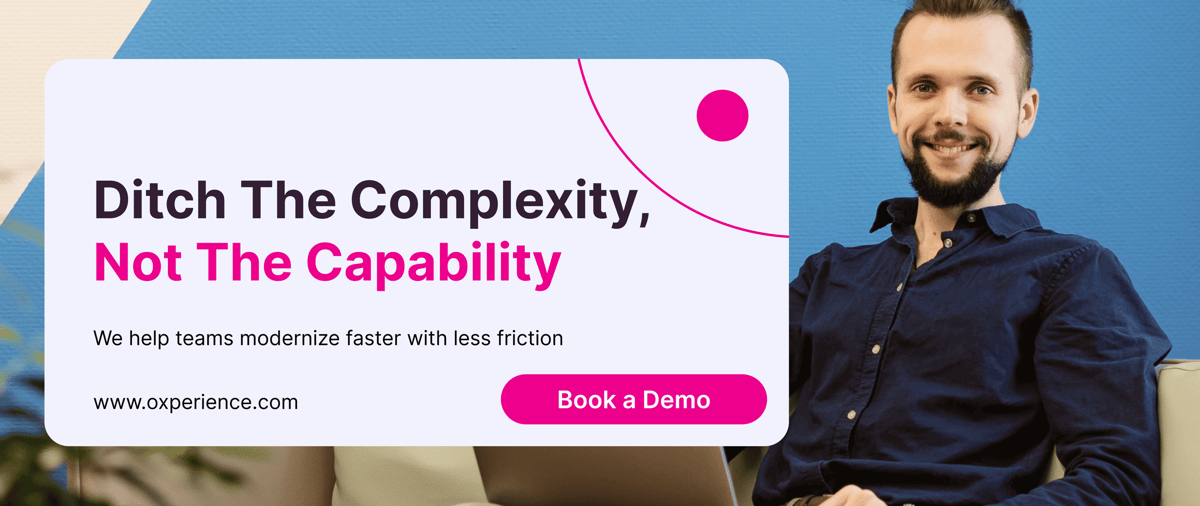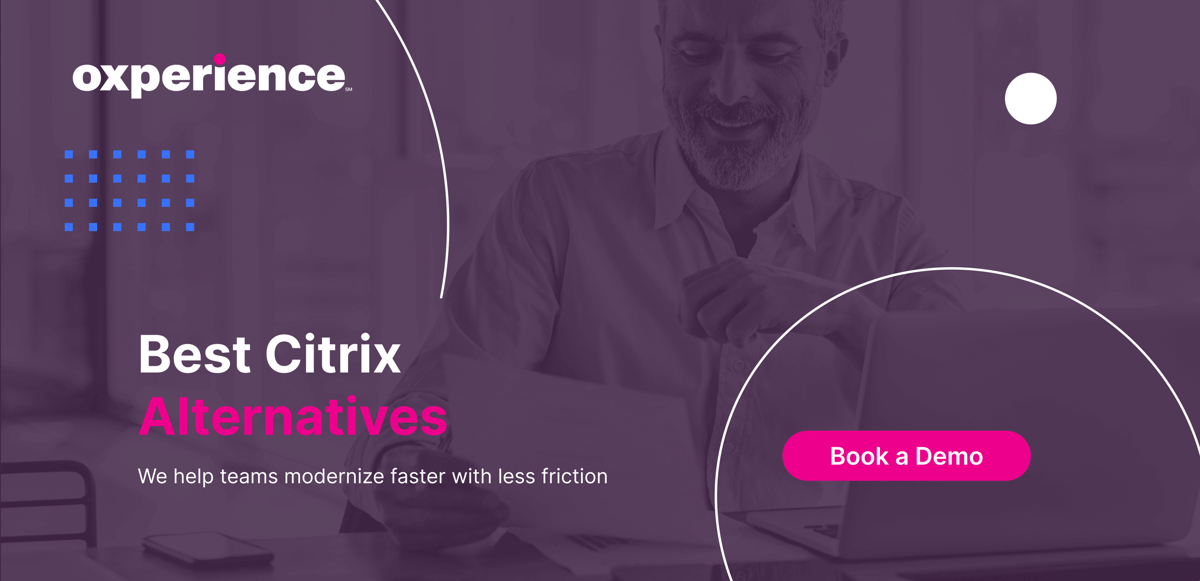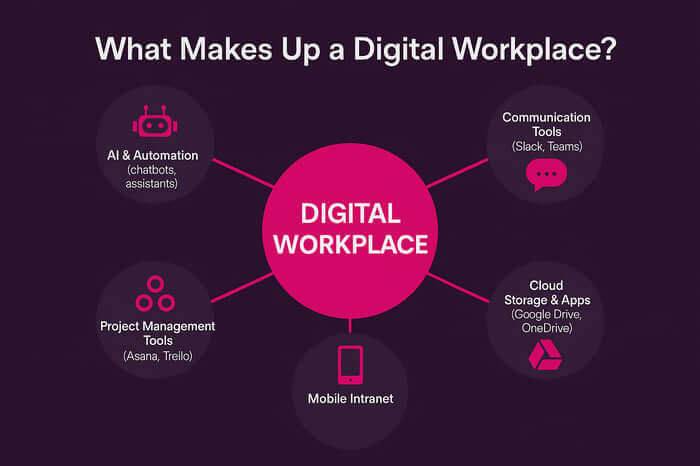Table of Contents
- Our Top 3 Picks
- 1. Microsoft Azure Virtual Desktop (AVD)
- 2. VMware Horizon
- 3. Amazon WorkSpaces & AppStream 2.0
- 4. Parallels Remote Application Server (RAS)
- 5. Nutanix Frame
- Comparison: Citrix Alternatives in 2025
-
- How to Choose the Right Citrix Alternative?
- What to Avoid When Replacing Citrix
- FAQs
-
- Conclusion
Citrix alternatives has long been the standard for virtual desktop infrastructure and application delivery, but 2025 brings new demands and more competition.
Whether you're fed up with licensing complexity, frustrated by clunky user experiences, or simply ready for a change, we’ll walk you through the top five Citrix alternatives worth considering.
Each platform below offers a different take on remote access, application streaming, and digital workplace delivery.
Some are cloud-native. Some offer hybrid flexibility. All are viable replacements – depending on what you're trying to fix.
Our Top 3 Picks
Best for Microsoft-Centric Teams: Azure Virtual Desktop (AVD)
Best for Hybrid Enterprise Environments: VMware Horizon
Best for Fast, Simple Deployment: Parallels RAS
1. Microsoft Azure Virtual Desktop (AVD)
AVD is Microsoft’s flagship desktop-as-a-service (DaaS) solution. It offers scalable cloud-hosted virtual desktops and application delivery, fully integrated with Microsoft 365 and the Azure ecosystem.
| What It Offers | Key Features |
|---|---|
| Windows 10/11 multi-session VMs | |
| Integration with Microsoft Intune, Entra ID (Azure AD), and Endpoint Manager | Auto-scaling based on usage |
| Support for hybrid Active Directory environments | RemoteApp streaming |
| FSLogix profile containers for faster login timesDeep integration with Teams and OneDrive |
| 🟢 Pros | 🔴 Cons |
|---|---|
| Seamless for Microsoft-centric organizations | Requires Azure know-how to configure and manage |
| Cost-effective licensing if you're already on Microsoft 365 | Licensing can still be confusing (Windows + RDS + Azure components) |
| Highly secure and scalable |
Best For:
Organizations already invested in the Microsoft ecosystem who want to simplify licensing and integration.
Why Choose AVD:
It’s the logical Citrix replacement for Microsoft-heavy environments that want cloud-first scalability without switching ecosystems.
4.8/5
2. VMware Horizon
VMware Horizon is a robust VDI and app virtualization platform that supports both on-prem and multi-cloud deployments.
Known for its powerful GPU support and enterprise-grade management tools.
| What It Offers | Key Features |
|---|---|
| Support for persistent and non-persistent desktops | Blast Extreme protocol for high-performance streaming |
| App Volumes for real-time app delivery | Instant Clone technology |
| Unified management with VMware Workspace ONE | Broad device support, including Linux VMs |
| Tight security integrations |
| 🟢 Pros | 🔴 Cons |
|---|---|
| Excellent for hybrid or multi-cloud VDI strategies | Higher cost and complexity |
| Mature and stable product with deep customization | Steep learning curve |
| Strong support for graphics-heavy workloads (CAD, 3D rendering) |
Best For:
Large enterprises needing tight control and hybrid deployment flexibility.
Why Choose VMware:
If you're managing a large or complex IT environment and need something powerful and battle-tested, Horizon is a solid Citrix replacement.
4.7/5
3. Amazon WorkSpaces & AppStream 2.0
AWS's virtual desktop (WorkSpaces) and app streaming (AppStream) services offer a scalable, fully managed cloud-native alternative to Citrix.
| What It Offers | Key Features |
|---|---|
| Desktop-as-a-service via WorkSpaces | Simple integration with Active Directory |
| App-only streaming via AppStream 2.0 | Fully managed infrastructure |
| Pay-as-you-go pricing with automated scaling | GPU-enabled instances available |
| Native AWS management console access |
| 🟢 Pros | 🔴 Cons |
|---|---|
| Minimal overhead to launch and scale | Not as customizable as VMware or Citrix |
| Flexible pricing model | Limited native support for Windows 11 |
| Global availability across AWS regions | More DevOps-heavy configuration for complex use cases |
Best For:
Cloud-native teams or companies already operating in AWS.
Why Choose AWS:
If you want rapid deployment, simple pricing, and minimal infrastructure management, Amazon WorkSpaces and AppStream are ideal Citrix replacements.
4.5/5
4. Parallels Remote Application Server (RAS)
Parallels RAS is a lightweight, cost-effective Citrix alternative for delivering remote desktops and applications across multiple platforms.
| What It Offers | Key Features |
|---|---|
| Centralized management of virtual apps and desktops | Load balancing and auto-scaling |
| Support for HTML5, Windows, Mac, Linux, iOS, and Android clients | Support for RDSH, VDI, and Azure Virtual Desktop |
| Remote PC access and client management | |
| Built-in security features like MFA and encryption |
| 🟢 Pros | 🔴 Cons |
|---|---|
| Fast to deploy | Lacks some advanced customization and policy controls |
| Simple licensing | Limited GPU performance for high-end applications |
| Broad device compatibility |
Best For:
SMBs and mid-sized businesses that want simplicity and affordability.
Why Choose Parallels RAS:
If Citrix feels overkill and expensive, Parallels RAS delivers 80% of what most teams need with far less friction.
4.3/5
5. Nutanix Frame
Frame is a DaaS platform built for the cloud era. It offers high-performance virtual apps and desktops with deployment flexibility across public clouds or on-prem.
| What It Offers | Key Features |
|---|---|
| HTML5-based access to Windows desktops | One-click deployment |
| Integration with AWS, Azure, GCP, and Nutanix AHV | Multi-cloud architecture |
| Built-in user analytics | |
| Support for GPU-accelerated workloads |
| 🟢 Pros | 🔴 Cons |
|---|---|
| Extremely user-friendly | Smaller ecosystem compared to Citrix or VMware |
| No software install required on client devices | May require 3rd-party tools for deep policy control |
| Fast to scale across geographies |
Best For:
Tech-forward teams that want agility, simplicity, and cross-cloud support.
Why Choose Nutanix Frame:
If you're starting fresh and want a modern, intuitive Citrix workspace competitor, Frame is a forward-thinking option.
4.2/5
Comparison: Citrix Alternatives in 2025
Platform | Cloud-Native | Hybrid Support | Cost-Efficient | Fast to Deploy | Strong GPU Support | User-Friendly |
Azure Virtual Desktop | ✔️ | ✔️ | ✔️ (with M365) | ✔️ | ✔️ | ✔️ |
VMware Horizon | ✔️ | ✔️ | ❌ | ❌ | ✔️ | ❌ |
Amazon WorkSpaces | ✔️ | ❌ | ✔️ | ✔️ | ✔️ (AppStream) | ✔️ |
Parallels RAS | ❌ | ✔️ | ✔️ | ✔️ | ❌ | ✔️ |
Nutanix Frame | ✔️ | ✔️ | ✔️ | ✔️ | ✔️ | ✔️ |
How to Choose the Right Citrix Alternative?
No two teams operate the same, so there’s no one-size-fits-all Citrix replacement.
Your decision should come down to how your business works today and what kind of experience you want to deliver tomorrow.
Ask yourself:
Are you all-in on Microsoft or AWS? Stick close to what your team already knows (AVD or Amazon WorkSpaces).
Do you need strong on-premise or hybrid support? VMware Horizon or Nutanix Frame will give you the most control.
Is user experience and simplicity a priority? Frame and Parallels RAS are strong on UX without overcomplicating IT’s job.
What’s your IT team’s capacity? If you're looking to offload complexity, avoid platforms that require extensive customization and management.
And finally, think beyond the infrastructure.
Many organizations find that the success of a digital workplace solution hinges less on the platform and more on how it's onboarded, adopted, and supported.
What to Avoid When Replacing Citrix
Not all alternatives are built equally, and not every "replacement" will serve your actual needs.
Here are a few traps to steer clear of:
Overcomplicated Platforms
Avoid tools that require deep configuration or multiple bolt-ons just to do the basics. You’re moving away from Citrix to simplify, not swap one headache for another.
Low-Maturity Newcomers
There’s a surge of startups in the virtual desktop space.
While some show promise, many lack enterprise-grade support, SLAs, or real-world deployment experience. Vet vendors thoroughly.
Locked-In Ecosystems
Be wary of platforms that require total commitment to a specific ecosystem (unless you're already deep in it). Flexibility is key, especially as workforces and tool stacks evolve.
No Support for Hybrid or BYOD
If your workforce is remote, mobile, or hybrid, steer clear of solutions that assume everything happens on a company-issued laptop behind a firewall.
Look for BYOD and multi-device support.
Vendors with a Poor Support Reputation
Customer service matters. Check third-party reviews, forums, and implementation stories. A platform is only as good as the support that stands behind it.
FAQs
Can I use multiple Citrix alternatives together?
Yes, many organizations mix solutions – e.g., Azure Virtual Desktop for internal staff and Amazon AppStream for contractor app access. Integration depends on your existing tech stack.
Which alternative is best for hybrid or remote-first companies?
Azure Virtual Desktop and Nutanix Frame are both strong for hybrid models. Parallels RAS also shines for fast mobile access.
What’s the most cost-effective Citrix replacement?
Parallels RAS offers the lowest barrier to entry, while Amazon WorkSpaces is budget-friendly at scale. Azure may offer savings if you're already in the Microsoft cloud.
Do these alternatives integrate with identity providers like Okta or Azure AD?
Yes. All five options support major identity providers, including SSO and MFA configurations.
Conclusion
Swapping out Citrix isn’t a light decision, but it’s also not one you need to overcomplicate.
Whether you’re after tighter integration with your existing tools, lower licensing overhead, or just a cleaner experience for your end users, there are solid options on the table.
Azure Virtual Desktop fits naturally into Microsoft-heavy environments. VMware Horizon brings muscle for hybrid deployments. Frame and Parallels keep things simple without cutting corners. And AWS delivers on scale and speed.
If you're thinking beyond infrastructure and care about how people actually experience these tools day to day, we can help. Get in touch to see how we support smoother onboarding, smarter access, and faster adoption – regardless of the platform you choose. Book a demo now!





